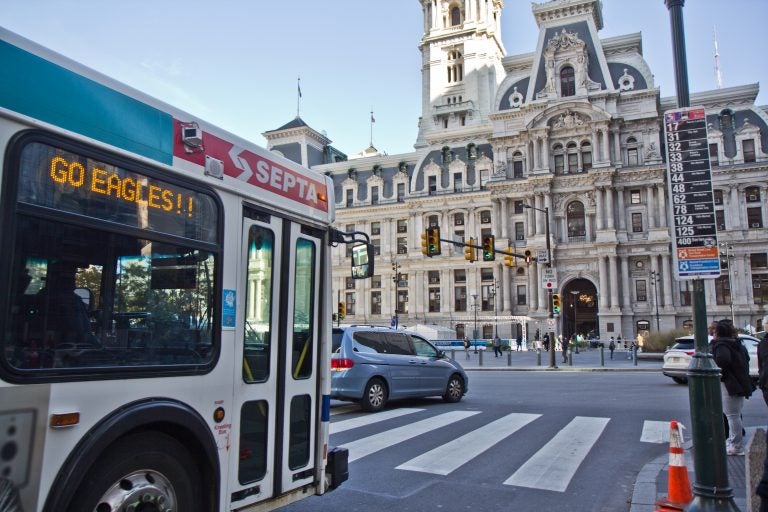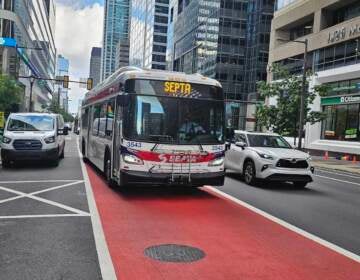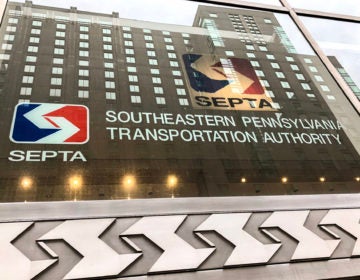The 3-second rule: Philly is giving Center City buses a teeny jump start
Skipping people in line is rude, but for SEPTA it may be a way to improve bus service.

SEPTA buses are given a few seconds ahead of regular traffic to turn, denoted by a vertical white line, at City Hall in Philadelphia. (Kimberly Paynter/WHYY)
Skipping in line is a rude move, but for SEPTA, it may actually be a way to improve bus service.
That’s why the transit agency and the City of Philadelphia are testing a new traffic signal at the corner of 15th and Market streets designed to give buses a three-second head start over traffic.
It’s called a queue jump signal and is already used for trolleys. Officials hope that bringing the signals to busy bus corridors will help improve service and ease congestion in increasingly traffic-jammed Center City.
“We’re working with SEPTA to help transit move more efficiently throughout the city,” said Gus Scheerbaum, director of strategic initiatives for the city’s Streets Department. “We think this queue jump is a means to help save some time for transit users.”
Starting this month, SEPTA drivers approaching 15th and Market in the bus lane heading eastbound heed to the new LED traffic signal, which uses a white bar that tells them to stop or go. Drivers know to brake when the bar is horizontal and move again once it switches to vertical. Drivers have three seconds to forge ahead into the intersection before the green light blinks on for other vehicles.
The three-second head-start is enough to prevent buses from getting blocked in by other vehicles at the intersection, Scheerbaum said.
“What this special signal does is that it provides a gap for the bus to pull out safely into the intersection before the rest of the traffic goes,” he said.
An annual report from King County Metro in Washington showed queue jump use on one line led to a nine-second reduction in delays during peak p.m. traffic times.
City workers installed the signal in October, and SEPTA said district managers were notified to inform drivers of the new system on Friday, Nov. 1. It might be some time before drivers get used to the new signals.
“This is counterintuitive to our operators’ personal and business driving habits,” said SEPTA spokesperson Carla Showell-Lee. “It takes some getting used to.”
Scheerbaum said the city chose to test the queue jump signal at 15th and Market in part because of its location close to the Streets Department’s office at 1401 JFK Blvd. Officials can see the action for themselves, which will yield observations that can supplement other data and inform where the signals go next.
Cars tend to block buses from re-entering traffic after picking up and dropping off passengers at the curb — a problem the queue jump should be able to mitigate.
“The locations where you want to use a queue jump are where you are having issues with buses being able to pull out into traffic,” Scheerbaum said. “And where transit is being slowed down because [buses] can’t get back into the flow of traffic.”
The city and SEPTA shared the cost of the signal, which cost less than $1,000.
Philly’s adoption of the jump signal comes as the latest in a series of efforts to improve transit as congestion grows and bus ridership lags.
City officials recently implemented pilots for loading zones that give delivery truck and ride-hailing drivers a place to pick up and drop-off. Other experiments include enforcement blitzes aimed at keeping drivers out of the bus lanes and a bill pending in City Council that would increase fines for parking violations that contribute to congestion.
Correction: This article was corrected on Nov. 7, 2019, to note that the full cost of the signal is less than $1,000.
WHYY is your source for fact-based, in-depth journalism and information. As a nonprofit organization, we rely on financial support from readers like you. Please give today.







